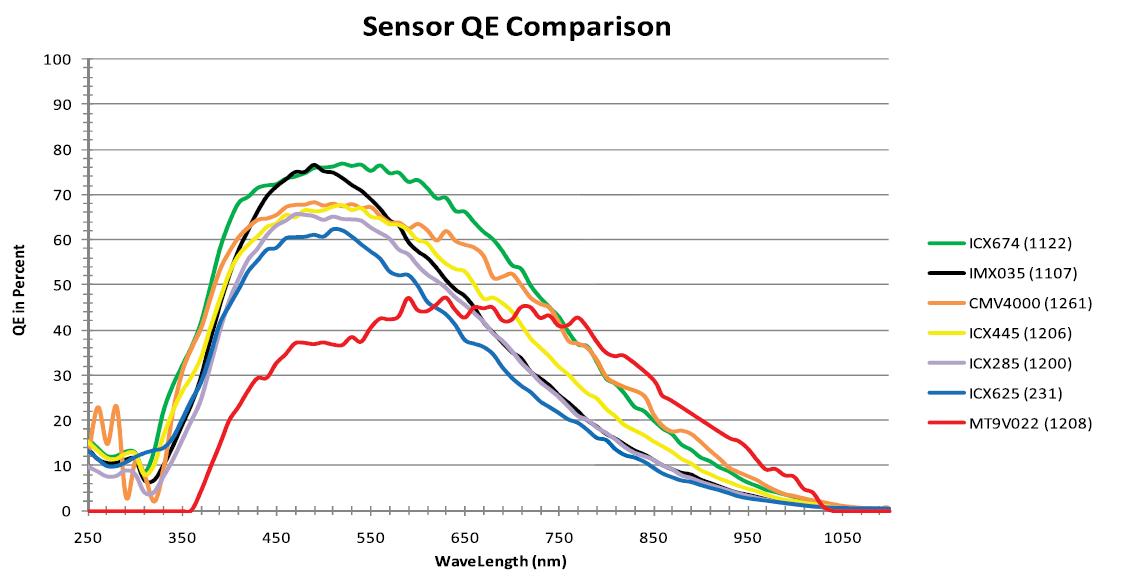
Brookhaven National Lab. This fraction is remarkably high for a thinned CCD. ‘Internal’ Quantum Efficiency If we take into account the reflectivity losses at the surface of a CCD we can produce a graph showing the ‘internal QE’ : the fraction of the photons that enter the CCDs bulk that actually produce a detected photo-electron.

(BNL), Upton, NY (United States) SLAC National Accelerator Lab., Menlo Park, CA (United States) Sponsoring Org.: USDOE Office of Science (SC), High Energy Physics (HEP) OSTI Identifier: 1361243 Alternate Identifier(s): OSTI ID: 1373199 Report Number(s): BNL-113862-2017-JA Journal ID: ISSN 1748-0221 Grant/Contract Number: SC0012704 AC02-76SF00515 Resource Type: Accepted Manuscript Journal Name: Journal of Instrumentation Additional Journal Information: Journal Volume: 12 Journal Issue: 04 Conference: Precision Astronomy with Fully Depleted CCDs, Upton, NY (United States), 1- Journal ID: ISSN 1748-0221 Publisher: Institute of Physics (IOP) Country of Publication: United States Language: English Subject: 79 ASTRONOMY AND ASTROPHYSICS Instrument optimisation Photon detectors for UV, visible and IR photons (solid-state) (PIN diodes, APDs, Si-PMTs, G-APDs, CCDs, EBCCDs, EMCCDs etc)The usual quantum efficiency (QE) measurement heavily relies on a calibrated photodiode (PD) and the knowledge of the CCDs gain. Of PhysicsPublication Date: Research Org.: Brookhaven National Lab. Wayne State Univ., Detroit, MI (United States). SLAC National Accelerator Lab., Menlo Park, CA (United States)These sensor testing solutions include wafer-level image sensor opto-electronical properties testing, wafer-level quantum efficiency testing of optical.
An unconventional reflectometer has been developed to make this measurement. 1 - R > QE, where R is the reflectivity, and over a significant wavelength range, 1 - R = QE. But reflectivity can also be used to verify QE measurements.
« lessAs part of the program to calibrate X-ray CCD detectors for the AXAF mission we have performed high-spectral resolution, absolute measurements of CCD quantum efficiency using the synchrotron radiation and grating monochromator facilities of the FM radiometry laboratory at BESSY. We obtain good agreement between 1 - R and the direct QE results. The goal is a 1 percent accuracy. Since the reflectivity of the LBNL CCDs might be as low as 2 percent this increases the signal to noise ratio dramatically. Unlike traditional schemes this approach makes only one reflection from the CCD surface. The beam intensity is measured directly with aPD, then both the PD and CCD are moved more » so that the optical path length is unchanged and the light reflects once from the CCD the PD current ratio gives R.
Finally, we demonstrate that edge structure can be reliably detected in CCD response using an electron impact source and a grating monochromator. The amplitude of edge structures in the back-illuminated devices is, as expected, much smaller. We find structure at energies immediately below the K absorption edge which we attribute to resonant absorption in the oxide layers of the CCD gate structure. Near-edge absorption structure produces variations as large as 40% in the detection efficiency of the front-illuminated more » detectors. The absolute scale of the measurements is established by reference to an Electrical Substitution Radiometer.
Quantum Efficiency Ccd Free Model Of
In this work, we present a method to infer a curl-free model of a sensor's underlying pixel grid from flat-field images, more » incorporating the superposition of all electrostatic sensor effects—both known and unknown—present in flat-field data. Such variation renders a critical assumption behind the traditional procedure of flat fielding—that a sensor's pixels comprise a uniform grid—invalid. This in turn requires an understanding of previously uncharacterized sources of systematic error in CCD sensors, many of which manifest themselves as static effective variations in pixel area.
« lessWe have developed optical filters for the German X-ray astronomy satellite ABRIXAS (A BRoadband Imaging X-ray All Sky Survey)(1). Furthermore, these errors scale linearly with the PRNU, so for future LSST production sensors, which may have larger PRNU, our method provides a way to assess whether pixel-level calibration beyond flat fielding will be required. For an LSST prototype CCD with pixel-response non-uniformity (PRNU) of 0.4%, we find the impact of "improper" flat fielding on these observables is negligible in nominal. Applying the method to DECam data recovers known significant sensor effects for which corrections are currently being developed within DES.
This was realized by a 0.80 m thick polypropylene foil, which is coated with approximately 60 nm aluminum on both sides. With respect to the mission goal in orbit a spectral transmission function is required attenuating radiation below photon energies of 10 eV by more than more » 7 orders of magnitude and transmitting soft X-ray photon energies above 1000 eV by more than 90 percent. Since these detectors are sensitive from the X-ray to the near infrared spectral range, X-ray observations require optical filters, which combine high transmittance for photon energies in the soft X-ray region and a high absorptance for ultraviolet and visible radiation.
We describe the measurements determining the spectral transmittance function in the center of the filters, and the transmission topography at discrete photon energies across the effective area, and present the resulting performance data. Synchroton radiation was used to characterize the properties of the filters in the soft X-ray photon energy range 60 eV

 0 kommentar(er)
0 kommentar(er)
